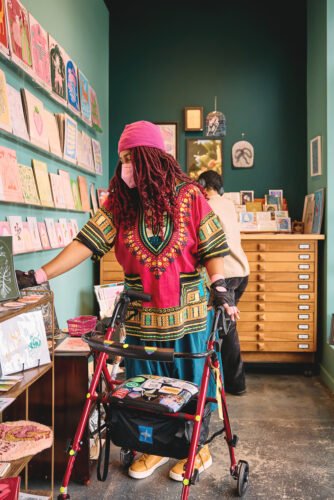Summary
Regular photo websites often don't have the best photos of diverse people, especially those with disabilities. But there are special websites that do a much better job! We also have some tips for searching any content library.
Finding diverse and authentic images for learning content goes beyond standard stock photo websites. While mainstream platforms are improving, dedicated and niche sources often provide much better quality and representation. Here are some excellent resources from Britne and Jeff’s recent talk, Disability and Diversity Representation in Learning – categorized for easier navigation!

Disability Representation
- Disability:IN Corporate Stock Photography – disability-inclusive stock photography specifically designed for corporate, depicting people with disabilities in the workplace authentically
- Disability Is Beautiful – free stock photos of disabled people, by disabled people
- Disabled and Here – disability-led stock image and interview series celebrating disabled Black, Indigenous, people of color (BIPOC)
Racial & Ethnic Diversity
- Nappy.co – beautiful free photos of black and brown people
- TONL.co – subscription-based culturally diverse stock photos that represent the true world we live in
- POCStock – high-quality stock photos, videos, and illustrations featuring people of color
Specific Diversity Representation
- AllGo – free plus-sized stock photos
- The Gender Spectrum Collection – stock photo library featuring images of trans and non-binary models that go beyond the clichés
- Age-Positive Image Library – a more realistic and diverse depiction of ageing to help challenge stereotypes of older people
Tips for Searching Other Collections
Are you limited to using a different stock photo library? Try these tips for better representation in learning:
- Be specific with your search terms. Instead of “diverse people,” try “Black woman in tech,” “person using a wheelchair in office,” “older man laughing,” “diverse students studying.”
- Consider the context! Does the image make sense in the context of your overall learning content? Does it genuinely support the message, or is it just there for “diversity’s sake”?
- Look for authenticity and avoid posed, generic, or overly “perfect” images. Look for natural expressions and real-life scenarios.
- Avoid stereotypes and be vigilant against images that perpetuate harmful or reductive stereotypes about any group.
- If possible, have individuals from the communities you’re trying to represent review your chosen images for authenticity and appropriateness.
In Summary
Regular photo websites often don't have the best photos of diverse people, especially those with disabilities. But there are special websites that do a much better job! We also have some tips for searching any content library.